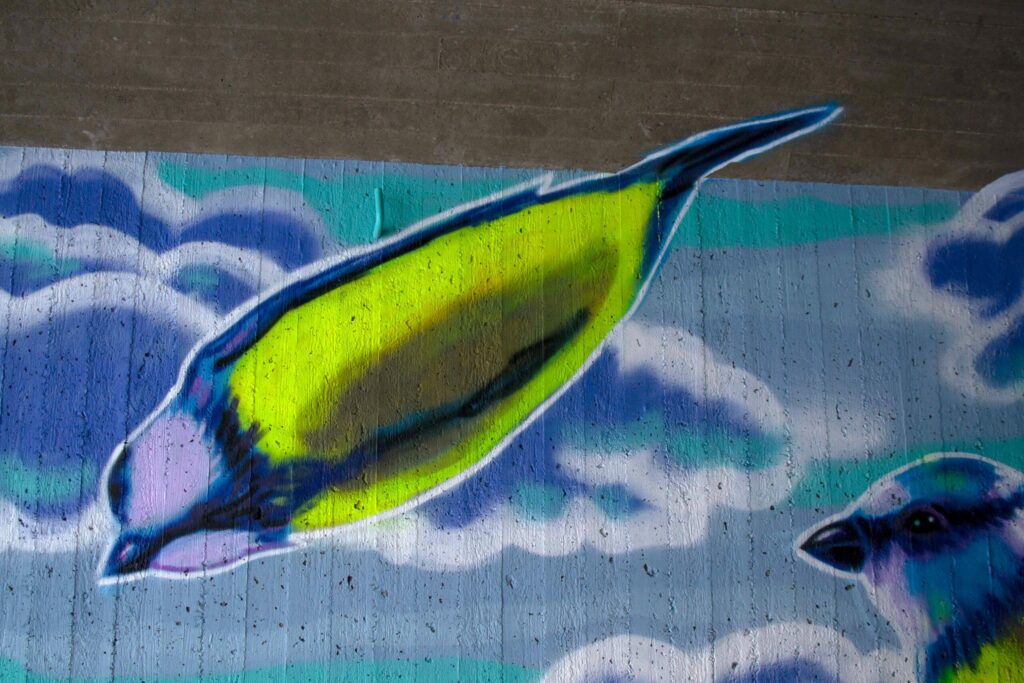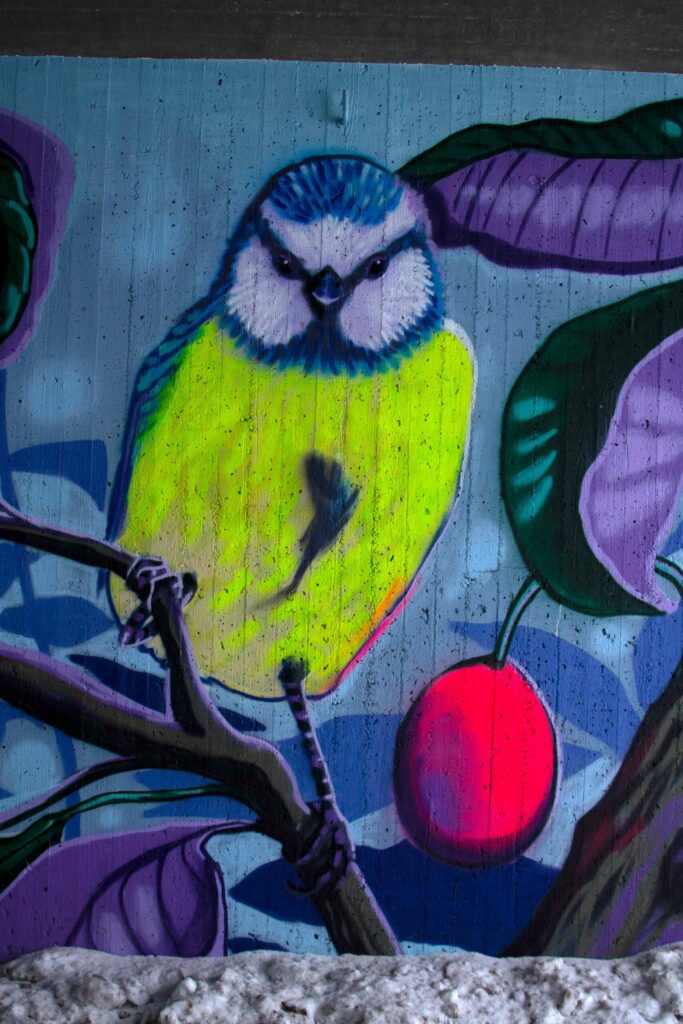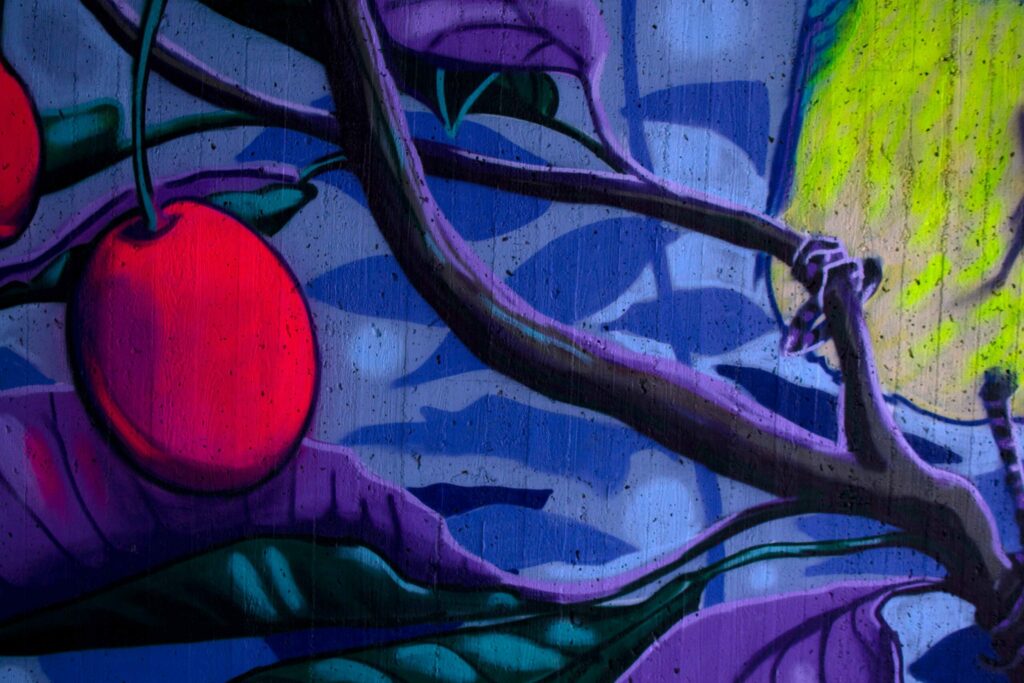WHAT DID YOU SEE WHILE FLYING?
2019. 26 m x 2,7 m.


The perception of color is affected by the wavelength of light, the light-reflecting properties of the material, and the eye that perceives the color. Humans perceive wavelengths of light from violet to red, while many birds, reptiles and insects are able to see ultraviolet color, that has shorter wavelength than violet. One of these species is the blue tit (Cyanistes Caeruleus), which is bird in the tit family, Paridae.
The blue tit's vision is affected by the cone cells in its eye, which have four types instead of the three types found in humans. Human perceives red, green and blue wavelengths. In addition to these, blue tit detects ultraviolet UVA wavelengths. The human retina would also register ultraviolet, but usually the cataract prevents ultraviolet light from entering the eye.
Seeing UVA wavelengths affects, for example, birds' search for food and mating. Some shades appear stronger to them than to humans and they can distinguish colors more precisely. For example, flowers and fruits reflect ultraviolet light. Birds of prey track mice using the UV reflection of mice’s urine marks.



According to researcher Muir D. Eaton, many species whose male and female plumage looks similar for observing human, differ to birds that see UVA light. Of the 166 species of sparrows previously classified as monomorphic studied by Eaton, 91.6% were sexually dimorphic when measured with a photo spectrometer (Eaton 2007, 156-157). The plumage of the male and female, which were previously classified as having the same appearance, was revealed to reflect UVA light in different ways and thus look different to the birds.
Researchers at the University of Gothenburg have discovered that the blue color area on the blue tit's head is visible to other blue tit as a strong reflection of UVA light. The ultraviolet saturation of this area separates the sexes from each other and affects blue tit mating. In accordance with selective mating, blue tits with an ultraviolet-saturated color area on their heads mated with each other. (Andersson, Örnborg & Andersson 1998, 446-447.)
What would it be like to see the world through the eyes of a blue tit? What is it like to be a bird?
It is basically impossible to show a blue tit's view containing ultraviolet light to a person whose color vision is focused on yellow and more limited than bird’s vision. In addition, it is impossible to know what it really looks like to a blue tit. However, I decided to imagine.
Some sources assume that people with aphakia could see UVA light. In aphakia, the eye is congenitally missing the lens of the eye, or it has been removed, for example, during cataract surgery. I read speculations that impressionist painter Claude Monet saw colors with a UV emphasis after cataract surgery and that his late production could be viewed from the perspective of ultraviolet vision.
Cynthia Tedore and Dan-Eric Nilsson have studied the UVA light reflection of leaves in a forest and were able to model a deciduous forest from a bird's perspective. In these models, the upper surfaces of the leaves glow pale purple or bluish and the leaf mass looks more contrasted. (Tedore & Nilsson 2019, 3-5.) When I was sketching, I looked at models of leaves and Monet's water lilies and took influences from them for the color scheme of the painting.


Psychoanalyst Harri Virtanen writes about eco psychology and the limits of the self: "The difference between the self and the material world is artificial, flexible. The self is a metaphor, its boundaries can be drawn anywhere" (Virtanen 2019, 10). If the perception of oneself shifts from an individualistic consumer to an organism that is dependent on its environment and a part of its environment, an activity that is harmful to the environment is also harmful to oneself. To get rid of the autonomous and independent person born with industrialization, one must look far: in the shamanistic and animistic world view, a large part of the soul is outside the body. For example, in the national epic of Karelia and Finland Kalevala, birds are quoting everyday messages, and metamorphoses from human to animal and from animal back to human are constantly happening.
There is a space between the bird's ears, which’s observations can only be presented to a human by imagining. We could certainly learn a lot from the blue tits. The world we see and experience is not the only possible one, and not even necessarily the most accurate one for observing the world.
I used fluorescent neon colors in the details of the birds and berries in the painting, with which I aim for a stronger color experience. The Eurasian blue tits in the painting are about human-sized or larger. I hope this makes the work more immersive so that the person entering the tunnel can be in a world of different scale and color experience for a moment. What kind of world of experience is really inside the blue tit's beautiful little head remains a mystery. However, it is interesting to aim for the unreachable.


Sources:
Andersson, Staffan, Örnborg, Jonas ja Andersson, Malte (1998) Ultraviolet sexual dimorphism and assortative mating in blue tits. Proc Biol Sci. 1998 Mar 22, 265, 445–450.
Eaton, Muir D. (2007) Avian Visual Perspective on Plumage Coloration Confirms Rarity of Sexually Monochromatic North American Passerines. The Auk 124(1), 155–161
Tedore, Cynthia & Nilsson, Dan-Eric (2019) Avian UV vision enhances leaf surface contrasts in forest environments. Nature Communications 10, Article number: 238
Virtanen, Harri (2019) Matkalla kohti ekologista itseä. Elonkehä 3/19, 7-13.
Location: Kempele, underpass on cycling and walking lane Baana
Comissioner: Kempele municipality
Size and technique: 2 x 13 m. x 2,7 m. Spray paint
Photos: Panu Johansson, Asko Leinonen, Leena Pukki